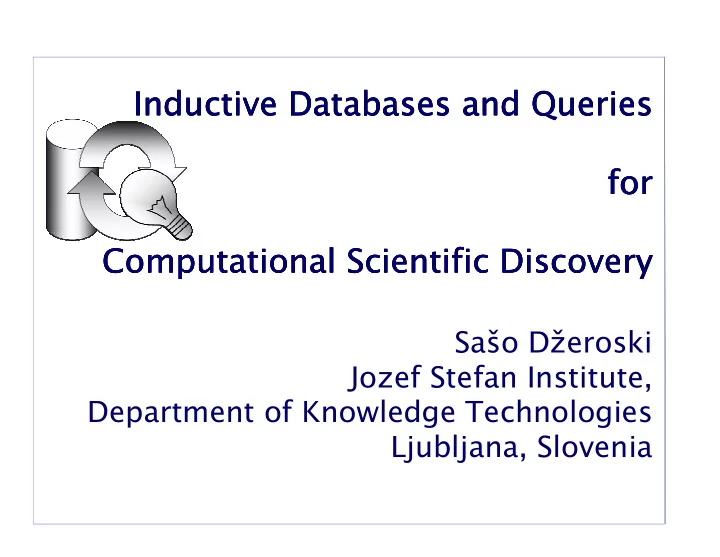

Inductive Inductive Inductive Inductive Databases Databases Databases Databases and� and�Queries and� and� Queries Queries Queries for for for for Computational Computational Computational Computational Scientific Scientific Scientific Discovery Scientific Discovery Discovery Discovery Sašo�Džeroski Jozef Stefan�Institute, Department�of�Knowledge�Technologies� Ljubljana,�Slovenia
Outline Outline Outline Outline • What�is�Computational�Scientific�Discovery – Introduction� – Examples�(ecological�models,�reaction�pathways) • What�are�Inductive�Databases�and�Queries – Introduction – Examples�(QSAR,�integrative�genomics) • How�the�two�can�be�connected,�i.e.,�how�Inductive� Databases�and�Queries�can�be�used�for� Computational�Scientific�Discovery�
Computational�Scientific�Discovery Computational�Scientific�Discovery Computational�Scientific�Discovery Computational�Scientific�Discovery • What�is�Scientific�Discovery:� The�process�by�which�a�scientist�creates�or�finds� some�hitherto�unknown�knowledge� such�as�class�of�objects,�an�empirical�law,�or�an� explanatory�theory • Computational�Scientific�Discovery�attempts�to� provide�computational�support�for�this�process – Early�research�reconstructed�episodes� from�the�history�of�science – Recent�efforts�in�this�area�have�focussed on� individual�scientific�activities� (such�as�formulating�quantitative�laws)�and�have�led� to�several�new�discoveries
Elements�of�Scientific�Behavior Elements�of�Scientific�Behavior Elements�of�Scientific�Behavior Elements�of�Scientific�Behavior • Scientific�knowledge�structures – Observations – Taxonomies: • Define�or�describe�concepts�for�a�domain,�along�with� specialization�relations�among�them • Specify�the�concepts�and�terms�used�to�state�laws�and� theories – Laws:� Summarize�relations�among�observed�variables,� objects�or�events – Theories:� • Statements�about�the�structures�or�processes�that�arise�in� the�environment • Stated�using�terms�from�the�domain's�taxonomy� • Interconnect�laws�into�a�unified�theoretical�account – Models,�Predictions,�Explanations�(Derived�from�above)
Elements�of�Scientific�Behavior Elements�of�Scientific�Behavior Elements�of�Scientific�Behavior Elements�of�Scientific�Behavior • Scientific�processes/activities�are�concerned�with� generating�and�manipulating�scientific�data�and� knowledge�structures • Scientific�activities – Collecting�data/observations – Formation�and�revision�of: • Taxonomies:� Organize�observations�into�classes�and� subclasses;�define�those�classes�and�subclasses • Laws:� Given�observed�data,�find�empirical�laws • Theories:� Given�one�or�more�laws,�generate�a�theory� – Deriving�models,�predictions,�and�explanations
Laws�of�Dynamic�Systems Laws�of�Dynamic�Systems Laws�of�Dynamic�Systems Laws�of�Dynamic�Systems’ ’ ’ ’ Behavior Behavior Behavior Behavior • Input:�Observed�behavior�of�dynamics�systems • Output:�Set�of�differential�equations
Explanatory�Models Explanatory�Models Explanatory�Models Explanatory�Models • Looking�deeper�into�the�model • Three�processes – Exponential�growth of�hare�population – Exponential�loss of�fox�population – Predator=prey�interaction between�the�two�species • Terms in�equations correspond to�processes
Domain Domain Domain Domain Knowledge Knowledge Knowledge Knowledge:�Generic�Processes :�Generic�Processes :�Generic�Processes :�Generic�Processes • Generic�process�for�predator=prey�interaction • Instantiation�to�specific�processes • In�this�case:�Pred=fox,�Prey=hare,�r=0.3,�e=0.1
Process Process Process Process= = = =based�Models�of� based�Models�of�Dyn based�Models�of� based�Models�of� Dyn Dyn Sys Dyn Sys Sys Sys • Input:�Observed�behavior�+�Set�of�generic�processes • Output:�Set�of�instantiated�processes�+�ODEs
Integrating�Data�and�Knowledge Integrating�Data�and�Knowledge Integrating�Data�and�Knowledge Integrating�Data�and�Knowledge • Using�different�types�of�domain�knowledge – Background�knowledge�on�basic�processes – Using�existing�models�and�revising�them – Completing�partially�specified�models
Example�Applications:�Ecology Example�Applications:�Ecology Example�Applications:�Ecology Example�Applications:�Ecology • Modelling aquatic�ecosystems� – Venice�lagoon – Lake�Glumsoe,�Denmark – Many�other:�Lake�Bled�(Slovenia),�Lake�Kasumigaura (Japan),�Lake�Greifensee (Switzerland),�Lake�Kinnereth (Israel),�Lake�Ohrid (Macedonia)
Example�Apps:�Metabolic�Networks Example�Apps:�Metabolic�Networks Example�Apps:�Metabolic�Networks Example�Apps:�Metabolic�Networks
CSD� CSD� CSD� CSD�Focusses Focusses Focusses Focusses • On�standard�scientific�formalisms�(e.g.,� equations,�pathways)�introduced�and�routinely� used�by�scientists • The�results�should�be�communicable�with�domain� scientists�and�publishable�in�relevant�scientific� literature • Integration�of�domain�knowledge�is�of�primary� importance�(e.g.,�concepts�from�the�relevant� scientific�domain,�existing�laws/models) • Interaction�with�domain�scientist�and�incremental� approach�also�crucial • Many�of�these�concerns�ill�met�by�data�mining,� some�addressed�by�inductive�databases/queries
Inductive�Databases�and�Queries Inductive�Databases�and�Queries Inductive�Databases�and�Queries Inductive�Databases�and�Queries • A�database perspective on�knowledge discovery: Knowledge discovery processes are�query processes • ”There is�no�discovery in�KDD, it’s�all a�matter of the expressive power of the query language” • Inductive database =�Database +�Patterns/Models • Sets of patterns can be materialized or�views • Data mining operations =�Inductive queries • IQ:�Inductive�Queries�for�Mining�Patterns�and�Models� (EU�funded�project,�Future�and�Emerging�Technol.)
Inductive�Queries Inductive�Queries Inductive�Queries Inductive�Queries • Inductive�query�=�Set of constraints that a� pattern/model has to�satisfy – Language constraints (only on�the pattern/model) – Evaluation constraints (concern the validity of the pattern/model with respect to�a�database) • Given�IDB�=�D�+�B�+�P,�we�have�diff�types�of�queries – Data Data Data retrieval Data retrieval retrieval (D�+�B� retrieval (D�+�B�= (D�+�B� (D�+�B� = = =>�D) >�D) >�D) >�D):�“classical” database query – Cross Cross Cross over Cross over over over (D�+�B�+�P� (D�+�B�+�P� (D�+�B�+�P� (D�+�B�+�P�= =>�D) = = >�D) >�D) >�D):�uses�patterns and data to�obtain new data – Processing Processing Processing patterns Processing patterns (P�+�B� patterns patterns (P�+�B� (P�+�B�= (P�+�B� = = =>�P) >�P):�patterns queried >�P) >�P) without access to�the data (post=processing) – Data Data Data mining Data mining mining (D�+�B�+�P� mining (D�+�B�+�P�= (D�+�B�+�P� (D�+�B�+�P� = = =>�P) >�P) >�P) >�P):�new patterns generated on�the basis of the data and the existing patterns
Inductive�Databases�for�QSAR Inductive�Databases�for�QSAR Inductive�Databases�for�QSAR Inductive�Databases�for�QSAR QSAR�=�Quantitative�Structure�Activity�Relationships • Basic�data�structure:�Molecule – Represented�as�labeled�graph,�or – relationally�through�atom/bond�facts • Patterns:�Molecular�fragments/substructures • Models:�Equations�(linear)�or�other�predictive�models� (e.g.,�regression�trees)�based�on�bulk�features�and� molecular�fragments�as�indicator�variables • Domain�knowledge:�Functional�groups
Inductive�Databases�for�QSAR Inductive�Databases�for�QSAR Inductive�Databases�for�QSAR Inductive�Databases�for�QSAR Inductive�queries • Find�frequent�patterns�(molecular�fragments) • Check�for�occurrence�of�fragments�in�molecules�to� obtain�features • Build�predictive�models�from�bulk�features�and� molecular�fragments/functional�groups�as�indicator� variables Underlying�application:�Drug�design
Recommend
More recommend